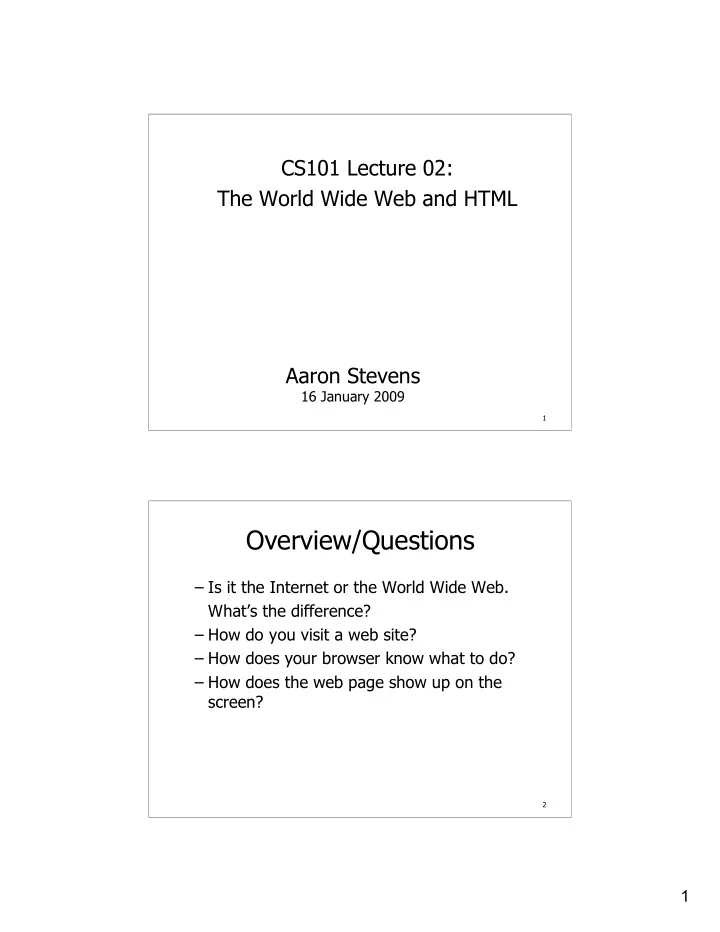

CS101 Lecture 02: The World Wide Web and HTML Aaron Stevens 16 January 2009 1 Overview/Questions – Is it the Internet or the World Wide Web. What’s the difference? – How do you visit a web site? – How does your browser know what to do? – How does the web page show up on the screen? 2 1
The Internet is a prerequisite for the World Wide Web. Internet or WWW? The Internet is like hardware… The World Wide Web is like software… 3 The World Wide Web The World Wide Web A system of interlinked hypertext documents and other resources (e.g. images) accessed via the Internet. The WWW was conceived of and first implemented by Tim Berners-Lee, circa 1989-1991. 4 2
The World Wide Web The World Wide Web A system of interlinked hypertext documents and other resources accessed via the Internet. Uniform Resource Locator A standard way of specifying the location of a resource, it’s name, and how to get it. Example: http://www.bu.edu/index.html http://bu.facebook.com/login.php 5 Displaying a WWW Page Figure 16.1 A browser retrieving a Web page How do you “visit a website”? 6 3
Displaying a WWW Page – Browser decodes URL to parse out host name and document location. – Browser makes network connection to server. – Client requests resource, and waits for the server to respond (using the hypertext transfer protocol). – Browser parses the response, requests any embedded data, and formats/displays output. 7 Protocol A protocol is a standard way of doing something. Hyper Text Transfer Protocol (HTTP) specifies how to request and deliver content (e.g. web pages). 8 4
Hyper Text Transfer Protocol HTTP is a protocol which specifies requests and responses between clients and servers. It assumes/builds upon: – The Internet exists/computer is connected – Reliable transport of data – Web servers are waiting to service clients HTTP is not limited to web pages -- It can be used to transfer any kind of data. 9 Mark Ups Figure 16.2 A marked-up document 10 5
HyperText Markup Language Markup language A language that uses tags to annotate the information in a document. Tags The syntactic elements in a markup language that indicate how information should be displayed. HyperText Markup Language (HTML) The language used to describe how to display the content of a Web page. 11 Hypertext Markup Language The HTML document defining the cheesy Student Dynamics Web page 12 6
Hypertext Markup Language The very cheesy version rendered by the web browser 13 Many HTML sources are a mess 14 7
Rendering a Web page After download, the browser renders the HTML into a graphical display. – HTML is a free-form language – Considers width and height of the browser window – Incorporates images, HTML tags, etc. – Browsers are inconsistent! 15 Hypertext Markup Language Tags are enclosed in angle brackets ( < . . . > ) Words such as HEAD, TITLE, and BODY are called elements and specify the type of the tag. Tags are often used in pairs, with a start tag such as <BODY> and a corresponding end tag with a / before the element name, such as </BODY> . 16 8
Hypertext Markup Language Tags/Elements: <HTML></HTML> -- denotes start/stop of HTML document <TITLE><TITLE> -- denotes start/stop of document title <BODY></BODY> -- denotes start/stop of document body <!-- … --> -- denotes start/stop of comments Some tags allow additional properties to be specified, e.g. BGCOLOR, TEXT, etc. 17 Hypertext Markup Language Tags/Elements: <P> -- creates a paragraph space <BR> -- creates a line break <H1></H1> -- creates a heading font (also, try <H2>,…) <B></B> -- creates bold text <I></I> -- creates italicized text <CENTER></CENTER> -- centers the text between the tags 18 9
Hyperlinks Hyperlinks are created using the HTML <A> tag. The HREF property gives a URL for the link. Example: This a link to <A HREF="http://www.bu.edu"> Boston University’s</A> web site. Having interlinked pages is what makes it a web! 19 Take-Away Points – Internet, World Wide Web – Browser – Protocol – HTTP – HTML Tags/elements Links 20 10
Student To Dos – Readings: Reed ch 2, pp 19-26 (today, Monday) – HW 01 is a take-home quiz, due by Tuesday 1/20. – Monday 1/19 is a University Holiday -- no class. 21 11
Recommend
More recommend